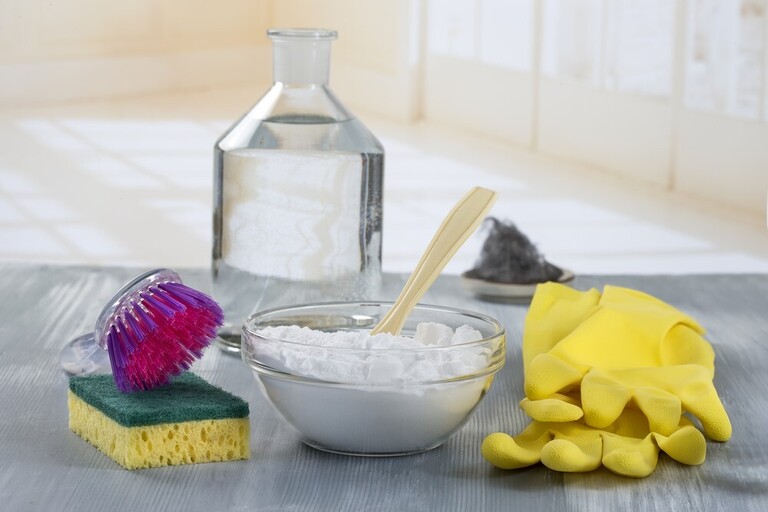
For those with a tighter budget but want a vintage vibe for their home, you can buy new wood and make it look as if it lived for decades under the sun and weather before being cut down.
The easiest and cheapest way to make new wood look old is using baking soda and vinegar. This post gives you some simple-to-follow methods.
Method 1
What you need:
- Baking soda
- White vinegar
- Water
- Sawhorse
- Plastic container
- Drop cloth
- Spray bottle
- Paintbrush
- Hard-bristle brush
- Rags.
Keep in mind that you can only use this method for tannic woods like cedar, redwood, pine, rea oak, and mahogany.

The idea behind this is to weather your wood using the elements. Even a sunny afternoon can make your furniture years older. Before doing anything, make sure that your wood is untreated so that baking soda can react with natural agents. Otherwise, you need to strip the wood and sand it down.
Next, choose a sunny yard. If you are working on 1-2 boards of wood, set up a sawhorse, if you are working on furniture, use drop cloths.
Now, mix water with baking soda at a rate of 1:1 in a plastic container, an amount enough to apply thickly over your furniture or wood.
Use the paintbrush to apply the baking soda paste thickly over the wood and leave it to dry under the sun for 6 hours. To speed up the process or intensify the reaction, you can spray white vinegar over the wood after covering it with baking soda paste.
After leaving the wood in the sun for a day, brush the dried baking soda mixture away using the hard-bristle brush.
Rinse the wood with water then use a clean cloth to dry it. Now, you will see that the wood has a grayish tint. If you want more impact, you can repeat the process.
Method 2
What you need: distilled white vinegar, fine steel wool, paintbrush, and a mason jar.
To get a grayish look for your wood furniture, you need to first tear up a #0000-grade steel wool pad, put 1.5 cups of white vinegar in the mason jar, and stick it in.

Next, screw the lid on.
You will see the rusting wool change the vinegar’s tint, which you will use to brush onto the wood. The color and darkness of the stain depends on the amount of steel wool applied and the time it’s left in the vinegar.
To get a weathered gray appearance, the steel wool needs soaking from 30 minutes to 2 days. By soaking between 30 minutes and 1 hour, you will get very subtle gray, by soaking for 2-3 hours, you will get grayer shades.
By soaking for 2 days, you will get silvery gray. Note that you should use lighter tints on blond woods and darker gray with brown woods or fade redwoods.

As soon as the solution is done, you need to remove the steel wood then drip the paintbrush into the vinegar. Apply this mixture on the wood, remember to let it dry completely before deciding whether or not to add the next layer.
Method 3
What you need: distilled white vinegar, fine steel wool, tongs, mason jar, paintbrush, tongs, rag.
To achieve warm weathered tones, you can use the same method as in recipe 2 to get a gray wood stain. However, this time, you will let the mixture sit for 2 days to 1 month, or even longer to get a deep, rustic brown. If the steel wool remains on the wood, you can remove it with rubber gloves or tongs.
You can test the stain on the wood, just paint a small area on the underside of the back of your wood to check out the resulting color.

Let the wood dry. If the resulting color turns out too dark, you can dilute the solution using some water.
Once you have got the color you want, you can apply the solution by following the grain. But remember to brush lightly and wipe the excess with the dry rag. Leave the wood to dry completely then decide if you want to add the next layer or not.
Method 4
What you need: white vinegar, glass jar, steel wool, black tea, paintbrush, sandpaper, hot/room-temperature water, plastic gloves, paste wax, rags

First, you need to make the vinegar solution by filling half the jar with vinegar, then shred the steel wool then add it to the jar. Leave the jar for 24 hours, the steel wool will dissolve.
Now, mix the tea with hot water in another jar. The tannins of the tea will react with the solution to form a darker finish.
If your wood is already finished or painted, you must sand it before you apply the stain.
Now, you need to apply the tea to your wood with the paintbrush. Let the tea dry then apply the solution.

As the solution dries, the aging process will go on, so you need to wait for it to dry completely before choosing to add a second coat.
Once you’ve got the color you look for, remember to apply paste wax to protect the finish.
Conclusion
So, in this post, we have introduced to you four easy recipes as to how to make new wood look old with baking soda and vinegar. As you can see, adding some aesthetic value to your furniture can be as simple as the ingredients in your kitchen, as long as you do it right.
We hope that you will find the perfect recipe for you here and will succeed in improving the look of your interior. Good luck!


